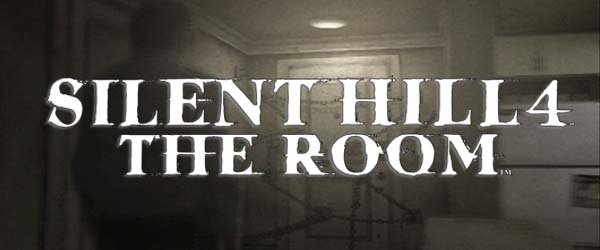
While I was playing through recent horror titles like The Evil Within, I noticed some interesting similarities with Silent Hill 4 that started to give me a new appreciation for some of this game's stronger aspects. In addition, while doing research for my Silent Hill timeline, I had to go back and play through Silent Hill 4: the Room again. I had only played through the game twice before, so I had to replay it in order to figure out how the timeline would work out. And while I was playing the game, I figured that I might as well go ahead and review it. At the time, it seemed like a novel idea to do a retro review of a Silent Hill game that wasn't Silent Hill 2, but lately, I've been seeing a lot of retro-reviews of The Room popping up other places. I haven't done any retro reviews yet; probably the closest thing has been my review of Demon's Souls. But in light of how unsuccessful the later Silent Hill games have been, the unfortunate cancellation of Silent Hills, and the uncertain future of the franchise (and of Konami as a studio), it's a good time to go back to look at what worked and what didn't about the previous games, and explore the question of whether we even want the franchise to continue.
The Room has the reputation of being the "bad" black sheep of the original Silent Hill tetralogy. I always thought that this reputation was unfortunate, and that the game wasn't quite as bad as people made it seem. I actually liked it better than Silent Hill 3 when I first played it, because I had never played the first Silent Hill. After I was able to track down a copy of the first game and play through it, Silent Hill 3 suddenly made a whole lot more sense, and I came to love it almost as much as I loved Silent Hill 2. So while I tend to agree that The Room is the "weakest" of the original Silent Hill games, I never really thought of it as being "bad"; just "less good". The release of future games by third party developers has only made The Room look better in retrospect.
An experimental formula
The game itself is a bit rough around the edges. It deviates significantly from the controls and mechanics established by the previous games in the franchise, and these changes are very hit-or-miss. This might be due, in part, to the possibility that The Room started out as an independent side project that was developed concurrently with Silent Hill 3, and that was eventually redesigned to work as a Silent Hill game in order to be more commercially viable. Whether or not that's true is still a hot issue of debate among the fanbase, but it's obvious to everybody that The Room plays a lot differently from previous titles.
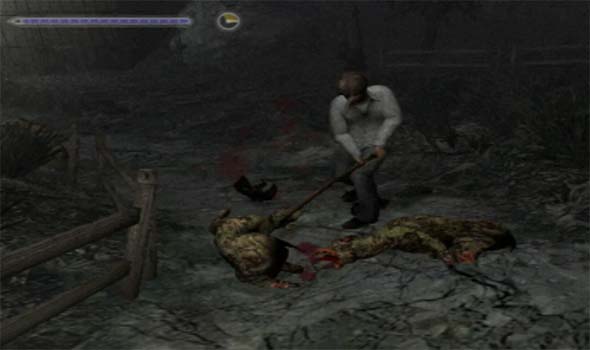
Movement and combat controls are radically changed from previous games in the series.
The most immediately obvious deviation is in movement and camera controls. The semi-first-person "tank" controls have been completely abandoned in favor of direct directional inputs, and the camera is significantly more limited than it has been in previous games. You can't snap the camera behind the character by holding the "look" button as you could do in previous games. Almost all camera angles are pre-set angles, and the player can usually only toggle between two possible camera angles in any given area.
This results in some very clumsy navigation of the environment, and it's very easy for the character to get turned around when camera angles flip. Most of the time, a camera change will go without a hitch, but there are a few frames in the game that consistently result in erratic and unpredictable movement. It happens most often when a camera change occurs concurrently with a change in direction of the character (to navigate around a corner or an obstacle). If the player's timing for changing the character's movement direction is not perfectly-timed, then the character ends up turning around, which can result in getting stuck in a loop between the two camera angles. This is the very reason that I prefer the tank controls. They may be a bit cumbersome, but at least they're consistent and always relative to a single frame of reference (the character's position in the world), rather than to an unpredictable camera.
The second major change is to combat. The game was designed to have a greater emphasis on melee combat, complete with new target-locking controls, a variety of breakable melee weapons, very limited ammunition for guns, and an on-screen meter for charging power attacks. The new movement controls do make it a bit easier to maneuver around enemies (especially multiple enemies), but only if you're in an open space and the camera angle doesn't go all wonky on you. The mechanics are serviceable, and I don't think they're as bad as some critics insist.
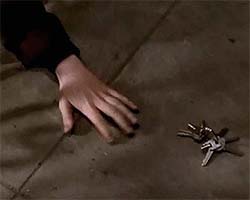
The designers were probably trying to mimic
the horror trope of fumbling for keys.
Inventory management is where things really start to get bad. Henry isn't a walking closet like the previous games' protagonists, and he has only a limited number of inventory slots. This is probably partly the result of the inventory being accessed in real-time by the directional buttons (which also might have played a role in the changes to the movement control scheme being entirely based up on the analog stick), in a desire to create a sense of frantically searching your pockets for a weapon or item while under pressure. It also adds more relevance to the Room 302 hub (another dramatic departure from previous games) by forcing you to go back to restock on supplies or swap out puzzle items.
But it's hindered by a lot of little mistakes... [More]
a5ccd49d-8af1-4839-8eb0-2796d3829980|6|4.5
Tags:Silent Hill, Silent Hill 4: the Room, Konami, Team Silent, KCET, Henry Townshend, Walter Sullivan, Eileen Galvin, room 302, horror, serial killer, murder, cult, occult, 21 Sacrements, sacrifice, ritual, ghost, escort quest, Alfred Hitchcock, retro review

In the comments of a recent post about Silent Hill 2's Otherworld, I had a discussion with a reader about the time period in which the Silent Hill games take place. This is actually an interesting and difficult topic, so I thought that I would dedicate a post specifically to it.
First and foremost, let's remind ourselves of when the games were released:
| Game title | Original release |
 | Silent Hill | January 1999 |
 | Silent Hill 2 | September 2001 |
 | Silent Hill 3 | May 2003 |
 | Silent Hill 4: the Room | September 2004 |
UPDATE 1 January 2020:
A recent tweet from Masahiro Ito claimed that Silent Hill 2 was set in the "late 70's or early 80's", which would make my estimates about 10 later than Masahiro Ito understood the setting to be. If we take evidence in the first Silent Hill game at face value, this would mean that Silent Hill 2 would have to take place prior to the events of Silent Hill, since Silent Hill can take place no earlier than 1987.
It is also possible that Ito's comment is referring to the aesthetics of the game (in keeping with many of the game's film and literary influences), and not necessarily to its actual timeline. It isn't that I don't trust Ito's memory or his authority, but Team Silent went to great pains to conceal the exact date of the games (as we'll discuss in the following post), so it seems that they wanted the years in which the games take place to be ambiguous to the players -- which kind of makes this entire exercise moot.
Contemporary fiction
It is very important to note that no specific dates ever appear in any of the Silent Hill games that were developed by Konami's internal Team Silent studio. If dates are provided, they are either only the month and day (and not the year), or they are time periods relative to the events of the game (such as referring to the "events of 17 years ago" in Silent Hill 3), or it is just the year of an historical event in the past (such as the document about the sinking of the Little Baroness). Even documents that you would expect to have dates (such as newspapers, journals, diaries, patient reports, and police records) are intentionally left dateless (or at least ambiguous).
In Silent Hill 2, there is a point in which James finds newspapers scattered around a hallway. Upon examining the floor or walls, James comments that the newspapers have today's date. This would have been a perfect opportunity for the developers to provide a specific date for the game, if they wanted to. They could have had James read the date on the paper to the player, or the paper itself (with its date) could have been made clearly visible. The developers didn't do this; they left it completely ambiguous.
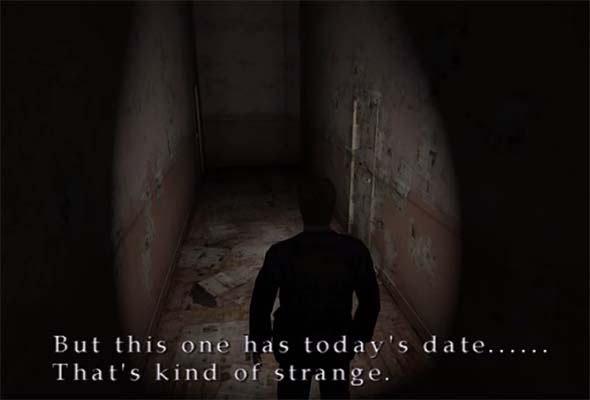
James notes that these newspapers have today's date, but doesn't tell us what the date is.
The developers went out of their way to not provide any specific dates for the games. Why would they do this? Typically, works of fiction that are not set in particular time period are written to be contemporary. Unless otherwise specified, most works of fiction should be assumed to take place now with respect to the consumption of the work by its audience, regardless of when "now" happens to be. if it's not contemporary to consumption, then it's usually contemporary to creation. This is usually pretty obvious if the work contains detailed descriptions of locations, technologies, and events that can be easily dated.
If we look at the original Silent Hill game in a vacuum, then the game provides no internal indication that it takes place at any specific time period. Players in 1999 probably had no reason to believe that the game took place in any year other than 1999. The same is true for Silent Hill 2, 3, and 4: if looked at in a vacuum, they can all be considered to take place in the same year that they were released. And if you didn't even know the year that the game was released, there's very little within the games to indicate that they take place at any time other than now.
However, this assumption falls apart because there is an absolute time difference of seventeen years between the events of the first game and the events of the third game, even though the difference in time between releases of the games was only four years. So we can't assume that each game takes place in the year of its release. At least one game has to be shifted on the timeline. So which game (or games) should be assumed to have taken place when? [More]
0ad2a2d3-abbc-4fd7-b255-126a5de4f3ba|8|4.8
Tags:Silent Hill, Silent Hill 2, Silent Hill 3, Silent Hill 4: the Room, history, Harry Mason, Heather Mason, James Sunderland, Maria, Henry Townshend, 1980s, 1990s, 2000s, 1986, 1987, 1994, 1999, 2003, 2008, 2016, Jeep Wrangler, telephone, cell phone, smart phone, rotary phone, computer, television, technology, anachronism, timeline, Konami, Team Silent, The Silence of the Lambs, Mary Shepherd-Sunderland
I frequently hear people bring up the infamous Fukuro video as a counter to my essay on why Silent Hill 2's Pyramid Head isn't a rapist. I haven't addressed this issue in the past because I actually don't know that much about the video or its creation. But I thought I would take a moment to address this issue. First off, let's watch the video in question (warning: contains disturbing content that may not be suitable for sensitive viewers).
This video was made by a small group of Team Silent members, most notably, Masahiro Ito and Akira Yamaoka, and it was included in a documentary DVD titled The Art of Silent Hill. There isn't really much information about this video on the internet other than speculation. As far as I know, Ito and Yamaoka have never made any public statements regarding its relevance to the canon of the games. When asked about the symbolism of the video on Twitter, Ito responded that it abstractly represented the womb.
Does an abstract representation of the womb have any relevance to Silent Hill 2? Not at all. It does, however, have strong ties to Silent Hill 3. In fact, the Fukuro girl character does make a brief appearance in Silent Hill 3! Perhaps Team Silent already had basic designs and outlines in place for Silent Hill 3 when they started work on Silent Hill 2, and the Fukuro video incorporated elements of both?
Fukuro's wiki page asserts that she was a scrapped monster from Silent Hill 2, however no citation is included for this claim, so I can't verify it. The wiki page goes on [without citation] to claim that Fukuro might have been another representation of James' subconscious (along with Pyramid Head). If that is true, then she may have been scrapped because the nurses and / or Maria may have made Fukuro's role superfluous and unnecessary.
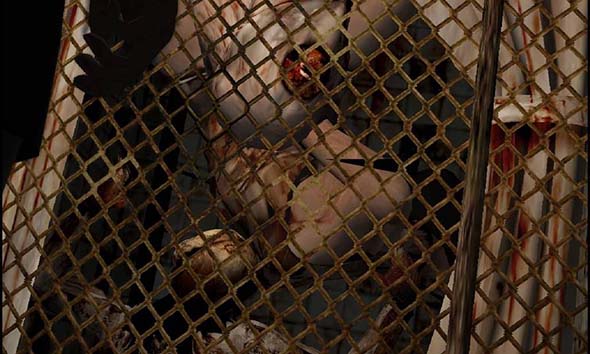
the Fukuro Lady appears briefly in an elevator scene in Silent Hill 3.
In any case, if Fukuro had been planned to be a monster symbolic of Jame's repressed sexual frustration, then it seems even less likely that Pyramid Head would also have represented the same element of Jame's subconscious! Pyramid Head and Fukuro's interactions in the Fukuro video could be symbolic of James' sexual desires being a source of guilt for which he wants punishment. In that case, guilt and sexual repression are still separate conditions represented by different manifested creatures that reinforce each other.
Fukuro's necessity in Silent Hill 2 was rendered moot by both Maria and the design of the nurses. It is possible that at some point during the game's design, Pyramid Head's role was intended to be different, and to be more representative of Jame's sexual urges. This could explain the creatures' visual design and the early cutscenes of him "raping" monsters. But as the game's development proceeded, Fukuro was dropped, Maria and nurses were added, and Pyramid Head's role became more explicitly representative of James' guilt and need for self-punishment as a result of Mary's death.
The bottom line is that the Fukuro video and Fukuro character are not in the actual game. At least not in Silent Hill 2. Masahiro Ito may very well believe that Pyramid Head is a sexually-symbolic monster, and he may very well have designed the creature with its Freudian aesthetic with that assumption in place. But for whatever reason, the scenario-writers decided not to pursue that avenue for the remainder of the game. Any lingering sexual symbolism for Pyramid Head is dropped within a couple hours of starting the game, and his role as a punisher is explicitly stated at the end of the game. At best, sexual aggression is a minor, implicit element of Pyramid Head's design; it is certainly not a defining characteristic of the creature, nor is it the creature's primary purpose.
A similar video was also made for Silent Hill 3, and features Robbie the Rabbit. This video also has no relevance to that game's plot.
[More]

Years ago, I wrote a post regarding the nature of Silent Hill's Otherworld and how it is most likely not a parallel dimension. In it, I may have made a significant mistake. Uh oh. Everybody makes mistakes, and I'm definitely not an exception. But no, I haven't changed my mind and conceded to parallel dimensions :P
Specifically, I failed to consider an important piece of evidence, and therefore may have mischaracterized the Lakeview Hotel Otherworld. In that post, I stated that the burnt-out version of the hotel was the Otherworldly-version that had been transformed as a kind of intermix between James' and Angela's Otherworlds. This is not necessarily true.
In fact, the burnt-out, waterlogged version of the hotel may not be the Otherworld at all. It could be the hotel in its natural state. The "normal"-looking version of the hotel may very well be the Otherworld one.
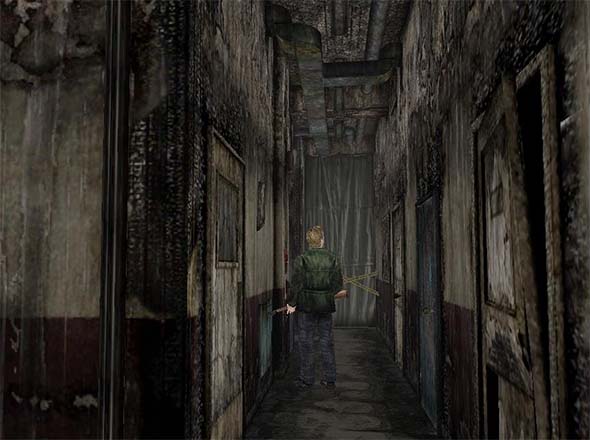
Is the Lakeview Hotel basement an Otherworld? Or is it the real hotel, as it currently exists?
In this post (as in others that I've written), I'm going to use the term "Otherworld" to refer colloquially to the areas of the game that have undergone supernatural transformations that modify the area substantially from its natural state. I still do not believe that the Otherworld is an actual "other world" that exists separately from reality. I still believe that the entirety of the Silent Hill universe (as created by the original developers) exists in our singular, real world, but is transformed via a supernatural force or entity that is native to the region.
Now, let's talk about the Otherworld in Silent Hill 2!
The Otherworld of Silent Hill 2 is a confusing and complicated issue in the series. Unlike the other games, SH2's Otherworld is much more subtle and restrained. This is due to two reasons. First, having a bloody, industrial Otherworld does not fit the story, since SH2 is a melencholy personal tale about James' mental state in the wake of his wife's death. It's not a game about a cult summoning a corrupt god to reshape the world into a hellish paradise.
Secondly, Silent Hill 2 deals - in part - with the state of the town after the events of Silent Hill [1]. Since Silent Hill shows signs of massive renovation and reconstruction efforts, it is reasonable to assume that Silent Hill 2 takes place shortly after the events of the first game (probably within a year or two; maybe even days or weeks), and that the town is still rebuilding from the devastation that it sustained from the first game. The cult has suffered losses in its leadership, a crisis of faith, and is also in a state of rebuilding and recruiting. As such, the cult does not play an active role in Silent Hill 2. With no God or psychic girl around this time to project her nightmares onto reality, the paranormal activity experienced by the characters of SH2 are likely a lingering effect of the spiritual and psychic interference of the first game. Because of this, the manifestations experienced are much more personal and subdued, as the influences must be pulled from the twisted minds of the few characters in the game.
In fact, the general consensus among Silent Hill fans is that SH2 only has between two and four full Otherworld levels... [More]
6637bd7a-f23b-4eae-b81c-c319b1ffd1b3|12|4.8
Tags:Silent Hill, Silent Hill 2, Otherworld, James Sunderland, Lakeview Hotel, Mary Shepherd-Sunderland, Angela Orosco, fire, arson, space heater, delusion

In my previous blog entry about the history of Silent Hill's cult, I had originally intended to include a small section about the cult's name, as it is accepted by series fans: "The Order". However, it wasn't really relevant to the specific topic of the in-game cult history, since it is a more meta point about the games in general. So instead, I decided to make it a brief independent article:
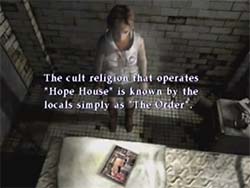
Joseph's article is the source of
the name "The Order".
I am one of a subset of Silent Hill fans who does not like using the term "The Order" to refer to the game's cult. For one thing, the name reminds me of the movie and Homecoming, which causes a resentful knee-jerk reaction. But there are also other in-game evidences to suggest that naming the cult might not have been intentional.
The primary source for the name "The Order" comes from an article written by the journalist Joseph Schreiber which details an orphanage that is run by a sect of Silent Hill's cult.
This article is present in Silent Hill 3 as well as Silent Hill 4: The Room, but there are slight differences in the text of the document in each game. Most noticeably, the name of the orphanage changes between the games. In Silent Hill 3 the article appears in a patient room in Brookhaven, and the orphanage name is given as "Hope House". In The Room, however, that same article gives the orphanage the name "Wish House". It was apparently changed sometime in the development of The Room, or it was mistranslated to begin with.
Silent Hill 4 also doesn't give us any indication as to whether the appearance of this article is intended to retcon the article in Silent Hill 3, or if it players are to assume that the actual text of the article changed at some point after the magazine's publication. Perhaps the article was reprinted in a different magazine and the editor or author changed the name. We don't know if it's the same magazine because in Silent Hill 3 the magazine is closed and we only see its cover and never the page of the article, but in Silent Hill 4 the magazine is sitting open on a desk and we see only the page of the article and not the cover.
"The Order" comes from an article that appears in both Silent Hill 3 (LEFT) and Silent Hill 4 (RIGHT).
But if the name of the orphanage changes between versions, can we trust the name of the cult to be correct?
As far as I can remember, "The Order" is never referred to anywhere else in The Room... [More]
9fac77d9-95be-4c33-a431-c4ba4970c07d|6|4.3
Tags:The Order, Silent Hill, Silent Hill 3, Silent Hill 4: the Room, Silent Hill Homecoming, movie, cult, occult, religion, church, Joseph Schreiber
|

| 12 | | | | | | | 60 | | 11 | | | | | | | 55 | | 10 | | | | | | | 50 | | 09 | | | | | | | 45 | | 08 | | | | | | | 40 | | 07 | | | | | | | 35 | | 06 | | | | | | | 30 | | 05 | | | | | | | 25 | | 04 | | | | | | | 20 | | 03 | | | | | | | 15 | | 02 | | | | | | | 10 | | 01 | | | | | | | 05 |
|